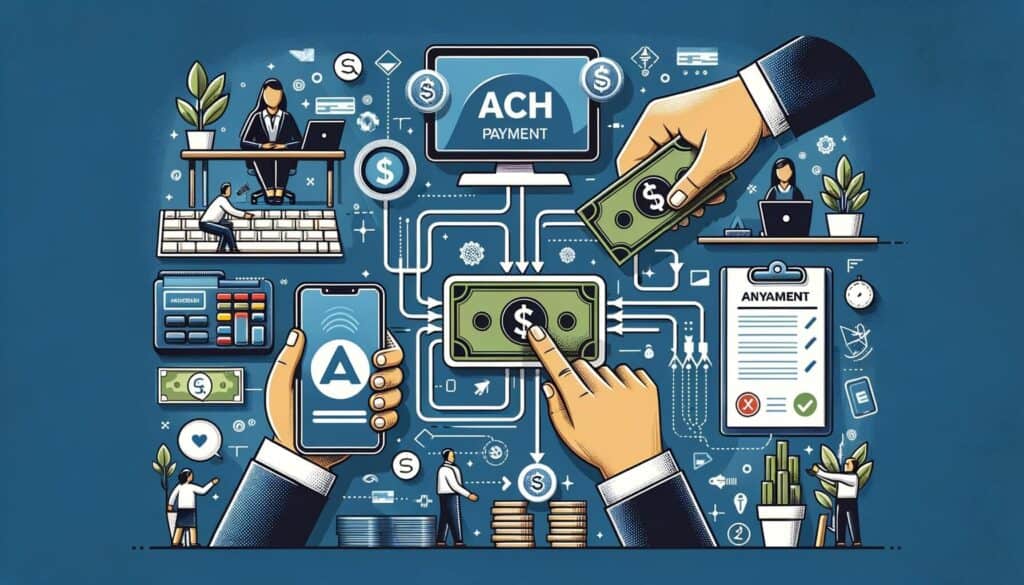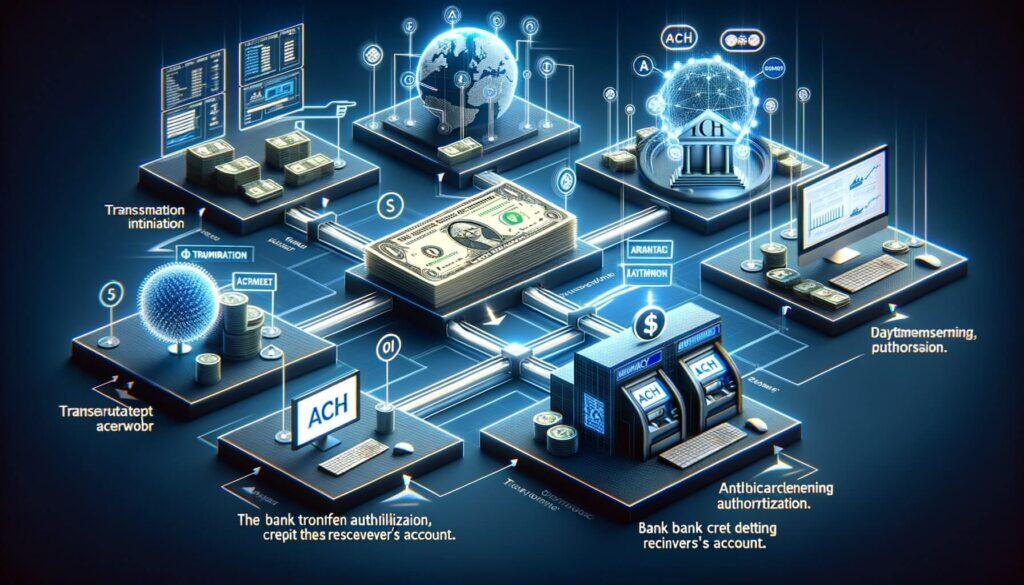
By Catharine Proctor April 28, 2025
In today’s digital age, electronic payments have become the norm for businesses and individuals alike. One such method is Automated Clearing House (ACH) payments, which offer a secure and efficient way to transfer funds electronically. This comprehensive guide will delve into the world of ACH payments, providing a step-by-step understanding of how they work, their benefits, limitations, and much more.
ACH payments are electronic transfers of funds between banks, allowing businesses and individuals to send and receive payments directly from their bank accounts. Unlike traditional paper checks, ACH payments are processed electronically, making them faster, more secure, and cost-effective.
How ACH Payments Work: A Step-by-Step Guide

To understand how ACH payments work, let’s break down the process into a step-by-step guide:
1. Initiation: The payment process begins when the sender (known as the originator) initiates a payment request. This can be done through various channels, such as online banking platforms, payment processors, or accounting software.
2. Authorization: The originator obtains authorization from the receiver (known as the beneficiary) to debit or credit their bank account. This can be done through signed agreements, online authorizations, or other legally binding methods.
3. Batch Processing: The originator collects multiple payment requests and consolidates them into a batch file. This file contains all the necessary information, such as the beneficiary’s bank account details, payment amount, and payment date.
4. Transmission: The batch file is then transmitted securely to an ACH operator, such as the Federal Reserve or a private ACH network. The ACH operator acts as an intermediary, facilitating the transfer of funds between banks.
5. Clearing and Settlement: The ACH operator processes the batch file, verifying the authenticity of each transaction and ensuring that the sender’s account has sufficient funds. Once verified, the funds are debited from the sender’s account and credited to the receiver’s account.
6. Notification: Both the originator and the beneficiary receive notifications confirming the successful completion of the ACH payment. These notifications can be in the form of email alerts, SMS messages, or bank statements.
Benefits of ACH Payments: Why Businesses Should Consider Using Them

ACH payments offer numerous benefits for businesses, making them an attractive alternative to traditional payment methods. Here are some key advantages:
1. Cost-Effective: ACH payments are significantly cheaper than paper checks or credit card transactions. Businesses can save on printing, postage, and processing fees, resulting in substantial cost savings over time.
2. Faster Processing: Unlike paper checks that require manual handling and transportation, ACH payments are processed electronically, reducing the time it takes for funds to be transferred. This enables businesses to improve cash flow and streamline their payment processes.
3. Enhanced Security: ACH payments are highly secure, with built-in encryption and authentication measures. The electronic nature of ACH payments reduces the risk of fraud, identity theft, and check forgery, providing peace of mind for both businesses and customers.
4. Recurring Payments: ACH payments are ideal for recurring transactions, such as monthly subscriptions or installment payments. Businesses can set up automatic debits from customers’ bank accounts, ensuring timely and hassle-free payments.
5. Wide Acceptance: ACH payments are widely accepted by banks and financial institutions, making them accessible to businesses of all sizes. This allows for seamless integration with existing accounting systems and payment processors.
ACH Payment Processors: Choosing the Right Provider for Your Business

When it comes to processing ACH payments, businesses have the option to work with ACH payment processors. These providers act as intermediaries, facilitating the transfer of funds between banks and ensuring compliance with ACH rules and regulations. Here are some factors to consider when choosing an ACH payment processor:
1. Security Measures: Look for a payment processor that prioritizes security and employs robust encryption and authentication protocols. This will help safeguard sensitive customer data and protect against potential cyber threats.
2. Integration Capabilities: Ensure that the payment processor seamlessly integrates with your existing systems, such as accounting software or e-commerce platforms. This will streamline your payment processes and minimize manual data entry.
3. Pricing Structure: Compare the pricing models of different payment processors, including transaction fees, monthly fees, and any additional charges. Consider your business’s transaction volume and choose a provider that offers competitive rates.
4. Customer Support: Opt for a payment processor that provides reliable customer support, including phone, email, or live chat assistance. This will be crucial in case of any technical issues or payment disputes.
5. Compliance and Regulation: Verify that the payment processor adheres to ACH rules and regulations, such as the National Automated Clearing House Association (NACHA) guidelines. Compliance ensures that your business operates within legal boundaries and avoids penalties.
ACH Payment Security: Ensuring Safe and Secure Transactions
Security is a paramount concern when it comes to electronic payments. ACH payments employ several security measures to protect sensitive information and prevent unauthorized access. Here are some key security features of ACH payments:
1. Encryption: ACH payments use encryption technology to secure data during transmission. This ensures that sensitive information, such as bank account numbers and personal details, remains confidential and cannot be intercepted by unauthorized parties.
2. Authentication: ACH payments employ various authentication methods, such as passwords, PINs, or biometric verification, to verify the identity of the sender and receiver. This helps prevent fraudulent transactions and unauthorized access to bank accounts.
3. Tokenization: Tokenization is a process that replaces sensitive data, such as bank account numbers, with unique tokens. These tokens are meaningless to hackers, making it virtually impossible to decipher the original data even if intercepted.
4. Fraud Monitoring: ACH payment processors often employ advanced fraud monitoring systems to detect and prevent fraudulent activities. These systems analyze transaction patterns, identify suspicious behavior, and trigger alerts or block transactions when necessary.
5. Compliance Standards: ACH payments adhere to strict compliance standards set by regulatory bodies, such as NACHA. These standards ensure that businesses and payment processors follow best practices to protect customer data and maintain the integrity of the payment system.
ACH Payment Fees: Understanding the Costs Involved
While ACH payments offer cost savings compared to traditional payment methods, there are still fees associated with processing these transactions. Understanding the costs involved will help businesses make informed decisions. Here are some common fees associated with ACH payments:
1. Transaction Fees: ACH payment processors typically charge a per-transaction fee, which can range from a few cents to a few dollars, depending on the volume and value of transactions. This fee covers the processing and settlement of each payment.
2. Monthly Fees: Some payment processors may charge a monthly fee for using their ACH payment services. This fee often includes additional features, such as reporting tools, customer support, or integration capabilities.
3. Return Fees: If a payment is returned due to insufficient funds or other reasons, the payment processor may charge a return fee. This fee covers the administrative costs associated with handling returned payments.
4. Setup Fees: Certain payment processors may charge a one-time setup fee to onboard businesses onto their ACH payment platform. This fee covers the initial configuration and integration of the payment system.
5. Additional Charges: Depending on the payment processor, there may be additional charges for services such as same-day processing, expedited settlements, or customized reporting. These charges vary among providers, so it’s important to review the pricing structure carefully.
ACH Payment Integration: How to Seamlessly Incorporate ACH into Your Systems
Integrating ACH payments into your existing systems is crucial for a seamless payment experience. Here are some steps to consider when incorporating ACH payments into your business:
1. Assess Your Needs: Determine the specific requirements of your business, such as the volume of transactions, recurring payments, or integration with accounting software. This will help you choose the right payment processor and ensure a smooth integration process.
2. Choose a Payment Processor: Research and select an ACH payment processor that aligns with your business needs and offers the desired features and functionalities. Consider factors such as security, integration capabilities, pricing, and customer support.
3. Gather Required Information: Collect all the necessary information from your customers, such as bank account details, authorization forms, and any other relevant documentation. Ensure compliance with data protection regulations and obtain proper consent from customers.
4. Configure Integration: Work with your payment processor to configure the integration between your systems and their ACH payment platform. This may involve setting up API connections, installing plugins, or customizing payment forms to match your branding.
5. Test and Validate: Before going live, thoroughly test the integration to ensure that payments are processed accurately and seamlessly. Conduct test transactions, verify reporting functionalities, and address any issues or discrepancies that arise.
6. Communicate with Customers: Inform your customers about the availability of ACH payments and the benefits they offer. Provide clear instructions on how to set up ACH payments, authorize transactions, and address any concerns they may have.
ACH Payment Limitations: What You Need to Know
While ACH payments offer numerous advantages, it’s important to be aware of their limitations. Here are some key limitations to consider:
1. Processing Time: ACH payments typically take 1-3 business days to settle, depending on the ACH operator and the time of submission. This may not be suitable for businesses requiring immediate funds or time-sensitive transactions.
2. Payment Reversals: Unlike credit card payments, ACH payments cannot be easily reversed once processed. If a payment needs to be refunded or canceled, businesses may need to follow a separate process, which can be time-consuming and involve additional fees.
3. International Transactions: ACH payments are primarily used for domestic transactions within the United States. International ACH transactions are limited and subject to specific rules and regulations, making them less accessible for businesses with global operations.
4. Limited Transaction Amounts: ACH payments have certain limitations on the maximum transaction amount. These limits vary depending on the ACH operator, the type of transaction, and the business’s relationship with the bank.
5. Authorization Requirements: ACH payments require proper authorization from customers to debit or credit their bank accounts. Obtaining and managing these authorizations can be a complex process, especially for businesses with a large customer base.
Frequently Asked Questions (FAQs) about ACH Payments
Q1. What is the difference between ACH payments and wire transfers?
Answer: ACH payments and wire transfers are both electronic payment methods, but they differ in terms of speed, cost, and transaction type. ACH payments are typically used for domestic transactions, take 1-3 business days to settle, and have lower transaction fees. Wire transfers, on the other hand, are often used for urgent or international transactions, settle within hours or minutes, and involve higher fees.
Q2. Can individuals use ACH payments, or are they only for businesses?
Answer: ACH payments are not limited to businesses; individuals can also use them to send and receive funds electronically. Many individuals use ACH payments for various purposes, such as paying bills, transferring money between accounts, or receiving direct deposits.
Q3. Are ACH payments secure?
Answer: Yes, ACH payments are secure. They employ encryption, authentication, and tokenization techniques to protect sensitive information during transmission. Additionally, ACH payment processors adhere to strict compliance standards to ensure the security and integrity of the payment system.
4. Can ACH payments be reversed or canceled?
Answer: ACH payments cannot be easily reversed or canceled once processed. If a payment needs to be refunded or canceled, businesses may need to follow a separate process, which can involve additional fees and time.
Q5. Are there any transaction limits for ACH payments?
Answer: ACH payments have certain limitations on the maximum transaction amount. These limits vary depending on the ACH operator, the type of transaction, and the business’s relationship with the bank. It’s important to check with your bank or payment processor for specific limits.
Conclusion
ACH payments have revolutionized the way businesses and individuals transfer funds electronically. With their cost-effectiveness, enhanced security, and seamless integration capabilities, ACH payments offer numerous benefits for businesses of all sizes.
By understanding the basics of ACH payments, how they work, their benefits, limitations, and choosing the right payment processor, businesses can streamline their payment processes, improve cash flow, and provide a secure and convenient payment experience for their customers. Embracing ACH payments is a step towards the future of electronic transactions, enabling businesses to thrive in the digital economy.